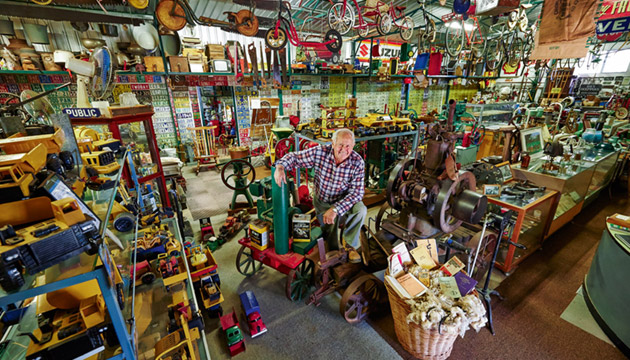People the length and breadth of the country are feeding their passion for collecting – from bottles and windmills to lace and chainsaws.
Story By Genevieve Barlow
He was 12 years old, an adventurous kid on a farm 50 kilometres “from anywhere”, when his boyish curiosity took him to the farm tip. There, he discovered ceramic and other bottles, the likes of which he’d never seen before. They’d been dumped way before municipal garbage collections began. He took them home, placed them under his bed, and then Kerran Howe, the bottle collector, came to be.
The bug that bit Kerran all those years ago still bites. Now aged 50, he has 5000 rare and unusual bottles. Every fortnight or so, when conditions are right and sometimes when they’re not, Kerran and his mate David Leslie go scratching around station dumps or scuba diving in the murky waters of inland rivers near early settlement station homesteads or their sites, searching for bottles.
They are collectors. Across Australia swarms of seekers just like them are scouring every nook and cranny for that elusive extra object. “We scuba dive with steel probes,” says Kerran, a Deniliquin-based merchandise manager for Landmark. “When we hit a bottle, it makes a sound like an echo. That’s when we dig it out. Most of the bottles we find in the rivers are whole, whereas on land there are a lot of breakages.”
Collecting in rural Australia appears, anecdotally at least, to have taken off since the 1960s, when the nation became wealthy enough to have spare time and when those old enough not to have lived through the labour-intensive eras of steam engines and hand-operated gizmos began to appreciate the simplicity and sophistication of Australia’s early European ingenuity. Others just got nostalgic for old times or loved things, sometimes beautiful, but often not. And others just got loaded with stuff. Such as Helen Walters.
When her husband died four years ago in a car crash, the Australian-made windmills he’d begun collecting 10 years previously fell to Helen to look after. “I had an interest in them but not as much as he did,” Helen says. “He’d just completed publishing an issue of The Windmill Journal when he died. Windmills were just a passion with him and he’d had this idea to display them on short towers so people could see how they worked. Normally they’re so high up you can’t see that.” Helen now curates the largest public collection of windmills in the Southern Hemisphere at the volunteer-run Morowa Museum, 160km inland from Geraldton, WA. Forty-six are displayed and there’s one at each entry to Morowa. They’re set out by year of production, showing progress from open geared (which required someone to climb and oil them) to oil-bath types. “We do want more and we’re always on the lookout for every type made in Australia,” Helen says.
This Story is from Issue #96
Outback Magazine: Aug/Sep 2014









